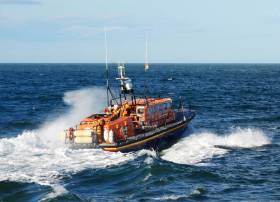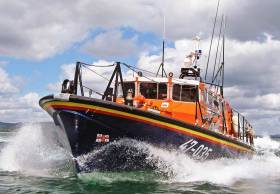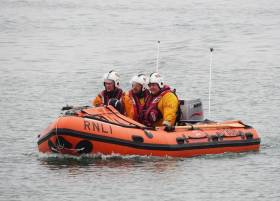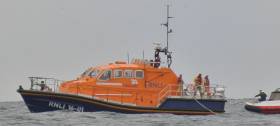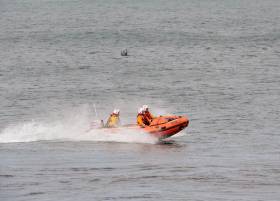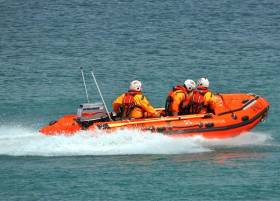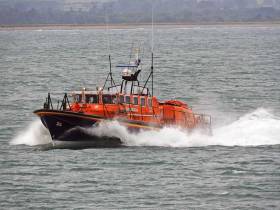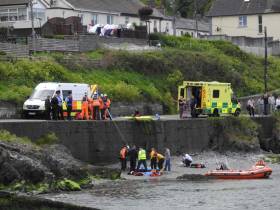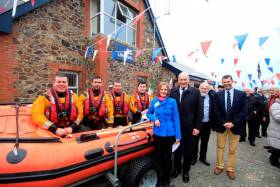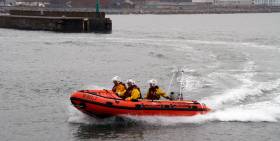Displaying items by tag: Wicklow
Wicklow Lifeboat Tows Five On Damaged Yacht To Safety
#RNLI - Wicklow RNLI’s all-weather lifeboat launched shortly before 6pm on Saturday evening (9 September) to assist a 13m yacht in difficulties off the Wicklow coast.
The yacht was on passage from Wales to Ireland when the forestay snapped on its mast rigging, some 23 miles off Co Wicklow.
Unable to use their sails in case the mast broke, the yacht’s crew were also low on fuel, which would prevent them from reaching Wicklow Harbour under their own power, prompting the skipper to call the Irish Coast Guard by VHF radio for assistance.
The Wicklow lifeboat Annie Blaker, under the command of coxswain Nick Keogh and with six volunteer crew, was alongside the stricken vessel at 7.20pm. Conditions at the scene were described as sea state moderate, wind Force 5, westerly in direction with good visibility.
A towline was quickly rigged to the yacht and the lifeboat crew began a three-hour tow back towards Wicklow Harbour, where the vessel and its five sailors were brought safely alongside the south quay at 10.20pm.
The crew on this callout were coxswain Nick Keogh, mechanic Brendan Copeland, Ciaran Doyle, Lisa O’Leary, Terry Sillery, Paul Sillery and John Stapleton.
Wicklow Lifeboat In Search For Overdue Kayakers
#RNLI - Wicklow RNLI’s all-weather lifeboat launched at 8.37pm last night (Monday 28 August) to search for an overdue kayak.
The two kayakers on board were reported overdue to the Irish Coast Guard by a concerned relative after he lost mobile phone contact with them and darkness was falling.
Under the command of coxswain Nick Keogh, the lifeboat was on scene 10 minutes after launching and began a search off Wicklow Head, with the crew quickly locating the kayakers in fading light near the Horseshoe buoy.
The man and woman had earlier left the beach at Ballinacarrig, near Brittas Bay, heading north for Wicklow Harbour. But as they approached Wicklow Head, the tide and current was too strong and they were being pushed back in a southerly direction.
Rescue 116 was also tasked along with a coastguard shore unit from Wicklow. They were stood down once the casualties were located.
The two kayakers were transferred onto the lifeboat and landed safely back at Wicklow Harbour shortly after 9pm, where they were reunited with their relieved family.
Keogh was joined on this callout by mechanic Dean Mulvihill, Ciaran Doyle, Tommy McAulay, David O’Leary and Connie O’Gara.
Wicklow Lifeboat In Medevac For Injured Sailor
#RNLI - Wicklow RNLI’s inshore lifeboat launched yesterday afternoon (Sunday 20 August) to assist Wicklow Ambulance Service with the medevac of a sailor who sustained injuries while sailing in the bay.
The lifeboat crew, comprising helm David O’Leary, Graham Fitzgerald and John Stapleton, transferred the casualty from the yacht at the east pier to the nearby slip, where they were met by a waiting ambulance crew.
Fastnet Callout Sees Baltimore Lifeboat Bring Two To Safety
#RNLI - Two people watching the Fastnet Race fleet round the famous rock from a RIB yesterday (Tuesday 8 August) were rescued by Baltimore RNLI when their boat lost power.
The volunteer lifeboat crew, who were already on exercise in the area of Fastnet Rock, were alerted by a call from a nearby vessel at 3.15pm that another boat with two people onboard had lost the use of their engine.
The all-lifeboat was only two miles from the casualty vessel, a 7.5m RIB. Conditions at the time were good with a north-westerly Force 2-3 wind and a one-metre sea swell.
Once on scene, the lifeboat crew established a tow and brought the vessel back to Baltimore Harbour in West Cork, securing her to the pontoon before returning to the lifeboat station at 4.20pm.
Kate Callanan, Baltimore RNLI volunteer lifeboat press officer, commented: “Thankfully the lifeboat crew were on scene very quickly after the call was raised.
“Baltimore RNLI has a strong connection to the Fastnet Race having been involved in a number of dramatic rescues over the years. The lifeboat crew regularly exercise during the famous race to be nearby in case they receive a call for help.”
Elsewhere, Wicklow’s all-weather lifeboat launched at on Monday night (7 August) to assist two sailors on a yacht in difficulties about two miles north-east of Wicklow Harbour.
The eight-metre yacht was on passage south when it developed engine problems. The skipper contacted the Irish Coast Guard for assistance as they were unable to make any progress due to the lack of wind.
Under the command of second coxswain Ciaran Doyle, the lifeboat was alongside the casualty six minutes after launching. Conditions in the area had a calm sea state with light airs and good visibility.
A towline was quickly established and the yacht was brought back to Wicklow Harbour, where it was safely secured alongside the East Pier before midnight.
#Rescue - A mother and her two children were rescued from a sea cave at Silver Strand yesterday afternoon (Saturday 29 July) in a joint operation between Wicklow RNLI and the Irish Coast Guard.
The two children had got into difficulty while swimming at the popular beach south of Wicklow Head, and their mother rushed to their aid – only for the three of them to be swept into a nearby cave.
Wicklow RNLI’s inshore lifeboat was launched at 4.40pm and arrived on scene with the Dublin-based coastguard helicopter Rescue 116, which lowered a winchman onto the beach to locate the casualties.
The Wicklow lifeboat followed shortly after, and helm Graham Fitzgerald brought the rescue vessel close to shore where the lifeboat crew spotted three people and the winchman in a cave.
Weather conditions in the area were windy, with a southerly Force 4 and high breaking surf at the mouth of the cave.
After an assessment by the winchman and lifeboat helm, it was decided that the winchman would lead the casualties to the adjoining cave, as rocks at the entrance would impede getting the boat close to shore.
Once the casualties were in the other cave, the lifeboat crew brought the boat onto the beach and all three were transferred to the lifeboat along with the coastguard winchman.
The mother and her two daughters were believed to have been on a day trip to the beach when they decided to go for a swim and one of them got into difficultly. Her sister had tried to help, but also got into trouble.
The mother then entered the water to help her daughters, which resulted in all three of them ending up in the cave.
The winchman, a trained paramedic, assessed the three casualties on the lifeboat and they were brought to Wicklow Harbour, where they were given hot drinks.
Wicklow RNLI were involved in a similar rescue at Silver Stand in 2014 when the lifeboat was called out to rescue a woman who had been swept into a cave after getting into difficulty swimming.
#RNLI - Wicklow RNLI’s inshore lifeboat was launched at 1.48pm on Saturday afternoon (24 June) after a member of the public reported a windsurfer in difficulty off Silver Strand, three miles south of Wicklow Harbour.
The lifeboat with three crew — helm Graham Fitzgerald, Vinne Mulvilhill and Connie O’Gara — was alongside the casualty seven minutes after launching. A local angling boat had also stood by the windsurfer until the lifeboat arrived.
The casualty was taken onto the lifeboat and assessed. He did not require any medical assistance and was landed safely back on Silver Strand a short time later.
Speaking after the callout, Wicklow RNLI lifeboat helm Graham Fitzgerald said: “We located the windsurfer about half a mile offshore. He had left the beach earlier but the wind dropped and he was unable to get back ashore.”
Wicklow Lifeboat Assists Whelk Fishing Vessel
#RNLI - Wicklow RNLI's all-weather lifeboat launched at 2.50pm yesterday afternoon (Wednesday 14 June) to assist the crew of a whelk fishing vessel off the Wicklow coast.
The skipper contacted Wicklow Head Coast Guard by VHF radio for assistance after a rope got caught in the trawler’s propeller.
The lifeboat, under the command of senior deputy second coxswain Tom McAulay and a volunteer crew, was alongside the casualty 40 minutes after launching at a point over 12 miles north of Wicklow Port near the Codling Bank.
While the lifeboat was en route, the three fishermen reported that they managed to clear the rope from the propeller and were able to get underway.
McAulay carried out an assessment and the lifeboat escorted the trawler while it crossed the Codling Bank.
Once satisfied that the obstruction was clear and the fishing vessel was capable of resuming its passage safely back to Wicklow Harbour, the lifeboat returned to station.
The crew on the call out were McAuley, mechanic Brendan Copeland, Terry Sillery, Carol Flahive, Lisa O’Leary, Paul Sillery and Dean Mulvihill.
#RNLI - Wicklow RNLI lifeboat pagers were activated at 12.24pm on Tuesday afternoon (16 May) after a cyclist had fallen from the quayside onto the Strand beach at Wicklow Harbour.
The volunteer inshore lifeboat crew were on scene within minutes and were met by ambulance personnel on the beach, who were assessing the casualty,
Due to the difficult rocky terrain of the beach and the rising tide, the lifeboat crew prepared a stretcher to transport the casualty by boat to the nearby slip.
With the arrival of an Irish Coast Guard cliff rescue unit, it was decided instead to use their specialist climbing equipment to winch the casualty off the beach by stretcher.
Many of the lifeboat crew had also assembled at the Strand and began to assist with the stretcher extraction.
The casualty was lifted from the beach up onto the road, and brought to hospital by a waiting ambulance.
“Our volunteer crew would like to wish the man a speedy recovery from his fall,” said lifeboat press officer Tommy Dover, adding: “This was also the first call out for our new inshore lifeboat Dennis-Audrey, which was officially named earlier this month.”
Wicklow D Class Lifeboat Named After Late Couple’s Dream to Fund a Lifeboat is Fulfilled
At a special ceremony held yesterday (Saturday 6 May), Wicklow RNLI officially named its new D class lifeboat, Dennis-Audrey.
David Delamer, chair of the RNLI Council in Ireland, accepted the lifeboat on behalf of the RNLI before handing her over into the care of Wicklow Lifeboat Station.
The funding for the new lifeboat came from Gladys Audrey Deakin, known as Audrey, who lived in Coventry, and left her residuary estate to the RNLI.
Audrey and her late husband Dennis loved holidays by the sea and were impressed by the work of the charity’s volunteers. It was their dream that their bequest be used to fund a lifeboat and that it would be named after them.
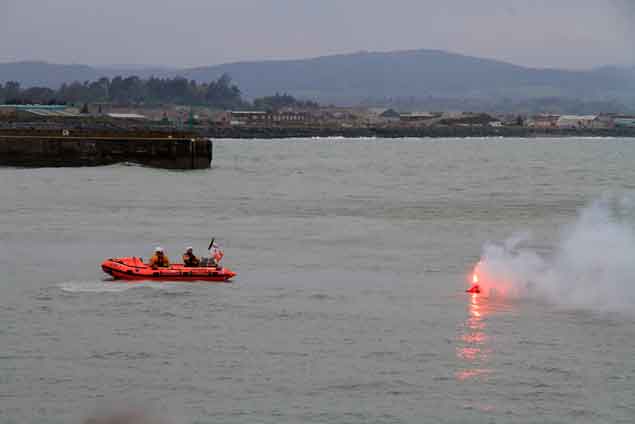 Wicklow RNLI performs a simulated exercise on the new lifeboat for well-wishers at the end of the naming ceremony and service of dedication for the D class Dennis-Audrey.
Wicklow RNLI performs a simulated exercise on the new lifeboat for well-wishers at the end of the naming ceremony and service of dedication for the D class Dennis-Audrey.
The couple were represented at the ceremony by Audrey’s solicitor Michelle Gavin who handed the lifeboat to the RNLI.
In his address, Mr Delamer said that one may be forgiven for thinking that we knew little about Audrey as Michelle’s relationship with her began posthumously as executor of her will.
‘But,’ he continued, ‘we know a great deal about her through one simple action; she has provided us with this life-saving vessel. That vessel has found a home here in Wicklow and will go on to save many lives and bring countless loved ones home. That one fact says a great deal indeed about Audrey and we will remember her for her generosity and her humanitarianism for many years to come.’
Phylis Whyte, former chair of the Wicklow RNLI fundraising branch had the honour of officially naming the lifeboat during the ceremony.
Des Davitt, Wicklow RNLI Lifeboat Operations Manager said the naming ceremony and service of dedication was a wonderful occasion in the history of the lifeboat station, and paid tribute to the generosity of Dennis and Audrey Deakin.
Speaking following the ceremony he said: ‘This new craft which will be housed and work alongside our all-weather lifeboat, gives our volunteer crew the power, equipment and rescue platform they need to keep those who use the sea safe.
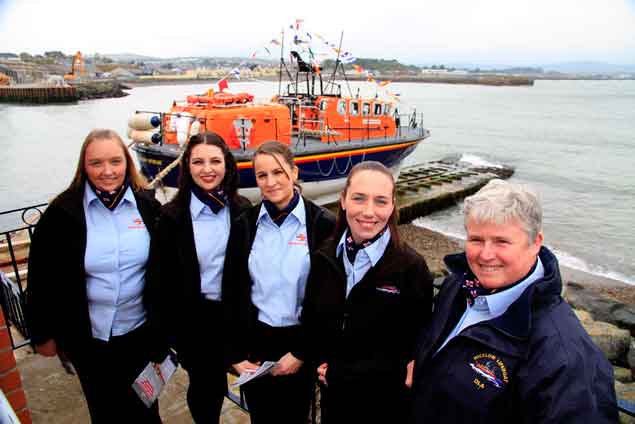 Wicklow RNLI female crew members Carol Flahive, Amy O’Neill, Brid Seoighe, Lisa O’Leary and Deputy Launching Authority Mary Aldridge.
Wicklow RNLI female crew members Carol Flahive, Amy O’Neill, Brid Seoighe, Lisa O’Leary and Deputy Launching Authority Mary Aldridge.
‘Every rescue is powered by our generous supporters, people like Dennis and Audrey. Their kind and selfless gift will help ensure we in Wicklow are ready for the next call, wherever and whenever it comes. For that, the RNLI and everyone at Wicklow lifeboat station will be forever grateful to them.
Mr Davitt paid tribute to the volunteers at Wicklow RNLI saying it was they who would give the new boat life: ‘Their commitment and ongoing attendance for training means that they are highly proficient in the operation of both our lifeboats. Further testament of the dedication of the crew is their knowledge that they may risk their own lives in the service of others. There is nothing greater that a person could offer and they deserve nothing less than the best lifeboat, equipment and training that money can buy.’
He thanked the local fundraising branch too, for their untiring work and praised the generosity of the people of Wicklow and further afield for helping to raise funds to enable the station to continue to save lives at sea.
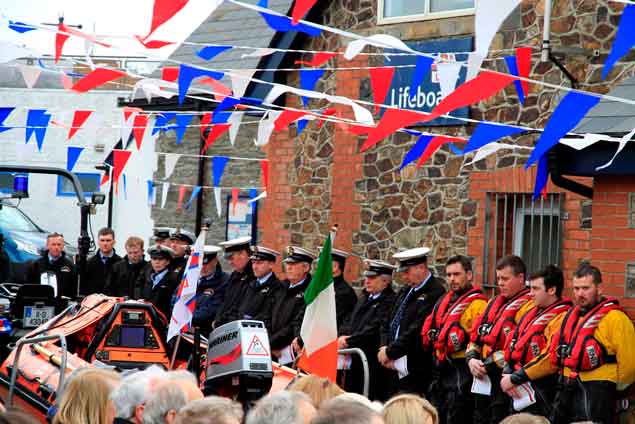 Wicklow RNLI lifeboat crew pictured alongside their new D class lifeboat Dennis-Audrey during the naming ceremony and service of dedication at Wicklow lifeboat station.
Wicklow RNLI lifeboat crew pictured alongside their new D class lifeboat Dennis-Audrey during the naming ceremony and service of dedication at Wicklow lifeboat station.
He added that while this was a time for celebration it was also a time to acknowledge the risks taken by all emergency service personnel in the service of others. A minutes silence was observed at the start of the ceremony in remembrance of five brave members of the Irish Coast Guard who lost their lives in the past year, Catriona Lucas, Dara Fitzpatrick, Mark Duffy, Ciaran Smith and Paul Ormsby.
Last year, Wicklow RNLI which also has an all-weather lifeboat launched 37 times and rescued 38 people. The all-weather Tyne class lifeboat Annie Blaker launched 21 times bringing 28 people to safety while the inshore lifeboat launched 16 times bringing 10 people to safety.
The new inshore lifeboat is replacing the Sheringham Shantymen, which was on service for 10 years at Wicklow RNLI. The lifeboat which was named after the Sheringham Shantymen was funded by money raised at their concerts. During its time in Wicklow, the lifeboat rescued 96 people, seven dogs and a farmer’s sheep.
First introduced into the RNLI fleet in 1963, the design of the inflatable D class lifeboat continues to evolve to meet changes in demand and technology.
It is the workhorse of the RNLI’s fleet and is ideal for working close inshore, near rocks or in shallow water in moderate conditions. It can be righted by the crew if it capsizes and is also part of the RNLI Flood Rescue Teams fleet of boats.
A highly manoeuvrable lifeboat, the D class can operate closer to shore than Wicklow’s all-weather lifeboat and comes into her own for searches and rescues in the surf, shallow water and confined locations - often close to cliffs, among rocks and even inside caves.
A lifeboat station was established in Wicklow in 1857. The first lifeboat was a 30ft rowing boat.
In 1911 the boathouse was adapted and the station’s first motor lifeboat, the first for Ireland, arrived.
In 1989, the boathouse was adapted once again and the slipway extended for the station's new Tyne class lifeboat. The adaptation to the boathouse included improved crew facilities and additional extensions for the refurbished winch and a souvenir sales outlet. The slipway was extended by 24 metres.
A D class lifeboat first went on service in Wicklow in 1995 with a new boathouse extension for housing the lifeboat completed in 1997.
A crowd of well-wishers turned up to see the lifeboat officially named with a bottle of champagne poured over the side of the boat by Phylis Whyte. Following the ceremony the crowd gathered around the harbour wall to see the lifeboat launch and watch as helm Alan Goucher, Connie O’Gara, Dean Mulvihill and Paul Sillery performed a simulated exercise.
Among the guests officiating at the ceremony were Judge Gerard Haughton, chair of the Lifeboat Management Group who welcomed guests and opened proceedings; Michelle Gavin, representative of the donor, who handed the lifeboat over to the RNLI, David Delamer, chair of the RNLI Council for Ireland, who accepted the lifeboat on behalf of the RNLI and handed her into the care of the lifeboat station and Des Davitt, Wicklow RNLI Lifeboat Operations Manager, who accepted the lifeboat on behalf of the station. A vote of thanks at the end was read out by Jill Clancy-Harold, Wicklow RNLI fundraising chair.
Father Donal Roche, parish priest, and Reverends Ken Ru and Jack Kinkead, led the Service of Dedication.
Sean Olohan and the Wicklow Swim for Life choir led the congregation in song
Wicklow RNLI to Name New Inshore Lifeboat
A new inshore lifeboat for Wicklow RNLI is to be officially named Dennis-Audrey during a ceremony at the lifeboat station at 4pm this Saturday 6 May.
The lifeboat which went on service in February this year was funded by Gladys Audrey Deakin who left her residuary estate to the RNLI for the funding of a lifeboat.
Audrey and her late husband Dennis loved holidays by the sea and were impressed by the work of the RNLI. It was their dream that their bequest be used to fund a lifeboat and that it would be named after them.
The donor will be represented by Audrey’s solicitor Michelle Gavin at the naming ceremony and service of dedication and she will officially hand the lifeboat into the care of the RNLI.
The honour of naming the lifeboat will go to Phylis Whyte, a former chair of the Wicklow RNLI fundraising branch.
Last year, Wicklow RNLI which also has an all-weather lifeboat launched 36 times and rescued 36 people. The all-weather Tyne class lifeboat Annie Blaker launched 21 times bringing 26 people to safety while the inshore lifeboat launched 15 times bringing 10 people to safety.
The new inshore lifeboat is replacing the Sheringham Shantymen, which was on service for 10 years at Wicklow RNLI. The lifeboat which was named after the Sheringham Shantymen was funded by money raised at their concerts. During its time in Wicklow, the lifeboat rescued 96 people, seven dogs and a farmer’s sheep.
Speaking ahead of Saturday’s naming ceremony, Des Davitt, Wicklow RNLI Lifeboat Operations Manager said: ‘The naming ceremony and service of dedication is a special occasion for our lifeboat station and we are grateful to Audrey and Dennis who generously funded our new lifeboat.’
First introduced into the RNLI fleet in 1963, the design of the inflatable D class lifeboat continues to evolve to meet changes in demand and technology.
It is the workhorse of the RNLI’s fleet and is ideal for working close inshore, near rocks or in shallow water in moderate conditions. It can be righted by the crew if it capsizes and is also part of the RNLI Flood Rescue Teams fleet of boats.
A highly manoeuvrable lifeboat, the D class can operate closer to shore than Wicklow’s all-weather lifeboat and comes into her own for searches and rescues in the surf, shallow water and confined locations - often close to cliffs, among rocks and even inside caves.
A lifeboat station was established in Wicklow in 1857. The first lifeboat was a 30ft rowing boat.
In 1911 the boathouse was adapted and the station’s first motor lifeboat, the first for Ireland, arrived.
In 1989, the boathouse was adapted once again and the slipway extended for the station's new Tyne class lifeboat. The adaptation to the boathouse included improved crew facilities and additional extensions for the refurbished winch and a souvenir sales outlet. The slipway was extended by 24 metres.
A D class lifeboat first went on service in Wicklow in 1995 with a new boathouse extension for housing the lifeboat completed in 1997.
The RNLI is a charity which relies on voluntary contributions and legacies.



























